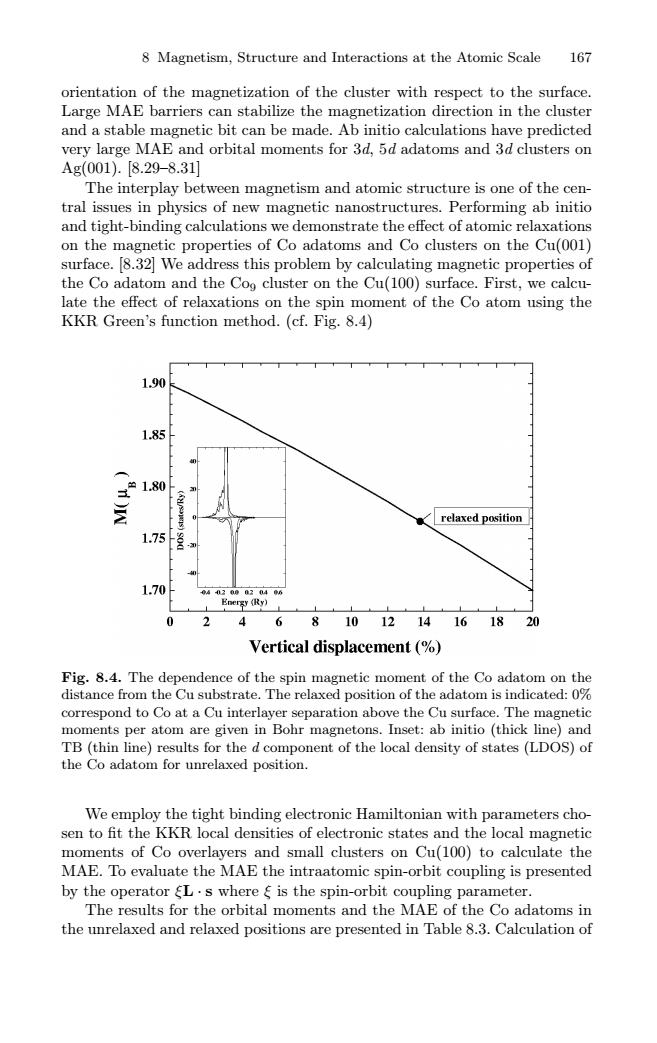正在加载图片...

8 Magnetism,Structure and Interactions at the Atomic Scale 167 orientation of the magnetization of the cluster with respect to the surface. Large MAE barriers can stabilize the magnetization direction in the cluster and a stable magnetic bit can be made.Ab initio calculations have predicted very large MAE and orbital moments for 3d,5d adatoms and 3d clusters on Ag(001).[8.29-8.31] The interplay between magnetism and atomic structure is one of the cen- tral issues in physics of new magnetic nanostructures.Performing ab initio and tight-binding calculations we demonstrate the effect of atomic relaxations on the magnetic properties of Co adatoms and Co clusters on the Cu(001) surface.[8.32]We address this problem by calculating magnetic properties of the Co adatom and the Cog cluster on the Cu(100)surface.First,we calcu- late the effect of relaxations on the spin moment of the Co atom using the KKR Green's function method.(cf.Fig.8.4) 1.90 1.85 ¥°1.80 relaxed position 1.75 1.70 04402000204●n Energy (Ry) 0 2 4 6 8101214161820 Vertical displacement (% Fig.8.4.The dependence of the spin magnetic moment of the Co adatom on the distance from the Cu substrate.The relaxed position of the adatom is indicated:0% correspond to Co at a Cu interlayer separation above the Cu surface.The magnetic moments per atom are given in Bohr magnetons.Inset:ab initio (thick line)and TB(thin line)results for the d component of the local density of states (LDOS)of the Co adatom for unrelaxed position. We employ the tight binding electronic Hamiltonian with parameters cho- sen to fit the KKR local densities of electronic states and the local magnetic moments of Co overlayers and small clusters on Cu(100)to calculate the MAE.To evaluate the MAE the intraatomic spin-orbit coupling is presented by the operator L.s where is the spin-orbit coupling parameter. The results for the orbital moments and the MAE of the Co adatoms in the unrelaxed and relaxed positions are presented in Table 8.3.Calculation of8 Magnetism, Structure and Interactions at the Atomic Scale 167 orientation of the magnetization of the cluster with respect to the surface. Large MAE barriers can stabilize the magnetization direction in the cluster and a stable magnetic bit can be made. Ab initio calculations have predicted very large MAE and orbital moments for 3d, 5d adatoms and 3d clusters on Ag(001). [8.29–8.31] The interplay between magnetism and atomic structure is one of the central issues in physics of new magnetic nanostructures. Performing ab initio and tight-binding calculations we demonstrate the effect of atomic relaxations on the magnetic properties of Co adatoms and Co clusters on the Cu(001) surface. [8.32] We address this problem by calculating magnetic properties of the Co adatom and the Co9 cluster on the Cu(100) surface. First, we calculate the effect of relaxations on the spin moment of the Co atom using the KKR Green’s function method. (cf. Fig. 8.4) Fig. 8.4. The dependence of the spin magnetic moment of the Co adatom on the distance from the Cu substrate. The relaxed position of the adatom is indicated: 0% correspond to Co at a Cu interlayer separation above the Cu surface. The magnetic moments per atom are given in Bohr magnetons. Inset: ab initio (thick line) and TB (thin line) results for the d component of the local density of states (LDOS) of the Co adatom for unrelaxed position. We employ the tight binding electronic Hamiltonian with parameters chosen to fit the KKR local densities of electronic states and the local magnetic moments of Co overlayers and small clusters on Cu(100) to calculate the MAE. To evaluate the MAE the intraatomic spin-orbit coupling is presented by the operator ξL · s where ξ is the spin-orbit coupling parameter. The results for the orbital moments and the MAE of the Co adatoms in the unrelaxed and relaxed positions are presented in Table 8.3. Calculation of